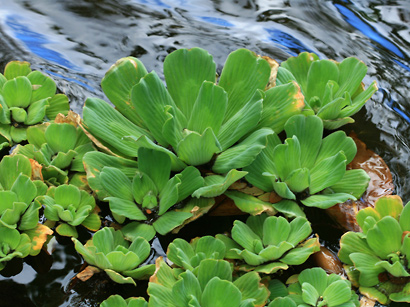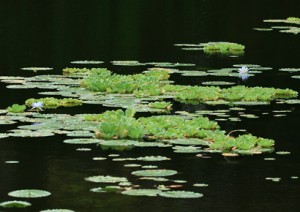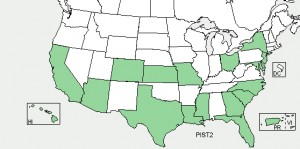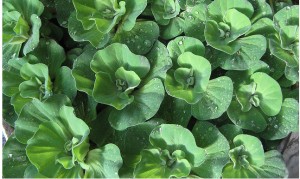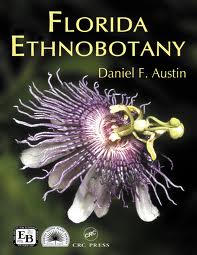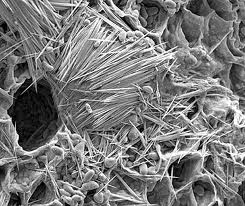No one knows if Water Lettuce is native to North America or not. Botanists disagree with some saying it’s from Africa, a few South America. Explorer and plantaholic William Bartram came through Florida in 1764/65, spied the Water Lettuce, drew it and wrote what he saw:
“…prodigious quantities of the pistia, which grows in great plenty most of the way [along the St. Johns River, Florida], and is continually driving down with the current, and great quantities lodged all along the extensive shores of this great river and its islands, where it is entangled… and… all matted together in such a manner as to stop up the mouth of a large creek, so that a boat can hardly be pushed through them, though in 4 foot water…”
The St. John’s is the only large river in the United States that flows north. (The Nile in Egypt flows north as do all the rivers in Siberia.) The St. John’s starts in earnest on the east coast of Florida at Lake Poinsett, not far from the Space Center and due west of Rockledge and Cocoa. Lake Poinsett used to be an ocean inlet and has skate in it that have adapted to the fresh water. The river then wends its way north between various limestone and other formations to exit at Jacksonville. We know Bartram got at least as far south as Orlando, which is a couple of hundred river miles upstream from the St. Johns’ outlet. As plants don’t float upstream how did the Water Lettuce get inland?
As the rhyme tells us Columbus sailed the ocean blue in 1492. Water Lettuce is found in Africa. If the Water Lettuce came from Africa one would need to find a ship that was in fresh water in at least Northern Africa that then came to the new world carrying the plant with it. Water Lettuce would then get somehow up the St. John’s River, not exactly navigable by ocean-crossing sailing ships. Smaller boats with bits of Water Lettuce could have been rowed up stream. Indeed, one theory is that trade with St. Augustine, founded in 1565, could have introduce the plant inland. However, if I may wander…
In the early 1980s, some 30 years ago as I write, I interviewed a man called Roy W. Wall. He was at the time, if I remember correctly, 101 and lived to be 107. He still worked every day at the local hardware store which was on the inner coastal water way where the cities of Cocoa and Rockledge meet. In fact, he still walked to work. He told me that when he was a boy — in the 1880’s — the St. Johns river, which starts as a dribble perhaps 20 miles to the south west of Melbourne, would flood via Lake Poinsett all the way east to what is now U.S. Route 1 and the adjacent rail road tracks at Barton Boulevard. He said you could see from U.S. 1 what looked to be people floating on a sea of grass but were actually people polling boats on the flooded St. John’s. It is but a half-mile from that site to the intracoastal waterway. A small boat for exploring could have easily been carried from the intracoastal waterway to the St. John’s at Rockledge, with a plant or two with it. Or a bud or two could have stuck to clothing. Incidentally I asked Wall if he had any insight as to why he made it past 100 and he said he never worried about anything. Roy Wall Boulevard in Rockledge is named for him.
Dr. Daniel Austin in his massive book Florida Ethnobotany never mentions Water Lettuce. That tells us which side of that debate he is on. However it arrived, by ship, shoe or seagull (say that fast 3 times), it’s been clogging Florida waterways for over 350 years. It was also one of the first plants I investigated decades ago. Water Lettuce, aka Pistia stratiotes, is not high on the edibles list, but it is edible after cooking, usually boiling. In times of famine it has been consumed in India, China and Africa. More specifically it was recorded as consumed during the Indian famine of 1877/78, in the Sudan during famines and that the Chinese eat young cooked leaves. The problem is calcium oxalate. The plant is loaded with it, as are many other members of the Arum family.
Calcium oxalate is in the form of crystals shaped like needles, raphides. Many plants have them, including some common edibles. The crystals mechanically burn the mouth and later can precipitate in the kidneys. Cooking can reduce the amount raphides, some with dry heat and others with moist heat. If you try to eat Water Lettuce raw it will severely burn your lips, mouth and tongue and more if you manage to swallow it. So don’t. If you do burn your mouth with some, immediate application of lime juice can ease the pain. If you cook it, try only a very small amount at first to make sure the burning element has been neutralized.
Water Lettuce, also called Water Bonnets, look like a floating open head of lettuce though the light dull green leaves are thick, ridged, and hairy. There are no leaf stalks, roots are light-colored and feathery. Flowers are inconspicuous. Linked plants can form dense mats, covering a lake shore to shore. They can stop boat traffic. I’ve had to tough my way through it many times with a canoe or kayak. It is considered a serious pest in Sri Lanka, Ghana, Indonesia and Thailand.
Studies indicate that Pistia stratiotes, a monotypic genus, possesses diuretic, antidiabetic, antidermatophytic, antifungal, and antimicrobial properties. The botanical name, Pistia Strateotes is all Greek. Pistia (PIS-tee-ah) is from pistos, meaning water. Stratiotes (stra-tee-OH-teez) means soldier and was a name Dioscorides used for some Egyptian water plant, perhaps the same one.
Green Deane’s “Itemized” Plant Profile: Water Lettuce
IDENTIFICATION: A floating, stemless herb with a submerged mass of fibrous, hollow, feathery-hairy roots and an above-water rosette six to eight inches wide of light green spongy, wedge-shaped oval leaves 1.25 to 5 inches long, 5/8 to three inches wide. Six to eight vertical veins, rough-velvety, notched at the apex, inflated at the base where they can be .75 of an inch thick. Tiny white flowers, whorl of male above, single female flower below, on a spadix. Fruit green, slimy, with brown cylindrical seeds. Plant sends out runners from the tips.
TIME OF YEAR: Year round in warm climates
ENVIRONMENT: Floating in water or stationary in very damp soil. Water Lettuce is found in the Old South north to New Jersey and New York in protected areas, and westward to Texas, Arizona and California. Also present in Hawaii, Puerto Rico and the Virgin Islands. It’s found in some 17 states and will tolerate moderate freezing.
METHOD OF PREPARATION: Cooking more or less reduces the calcium oxalate. Try a little first, wait a few minutes to see if a burn develops. The usual method of cooking is boiling.
Here’s a short video on the species by the state of Florida.

